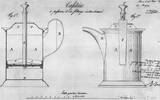Why should cappuccino be 11 points full? What is the coffee golden circle? Does the 1:1 ratio refer to milk, foam and coffee?
The name cappuccino is different from other espresso and sounds exotic. This makes many rookie friends who are not involved in the coffee shop give priority to cappuccino with distinctive names because the names on the menu are too strange when they step into the coffee shop to order. Of course, the end result of this choice is that most of them wear a mask of pain and are suffering.

As we all know, each kind of coffee has a different way of making it because of its different characteristics, and so is the cappuccino. But for a long time, three principles have been widely spread about the way cappuccino is made: first, the production ratio needs to be 1: 1; 2, the cup quantity needs to be 11% full; and 3, the coffee should be made with a "golden circle".

I believe most of my friends are at a loss. What is 1:1:1? Why do you want to achieve the full 11 points? What is the golden circle? It's only natural to be confused. after all, several versions of cappuccino have been changed in more than a hundred years. Of the three criteria, only one with a score of 11 has been used so far. However, their appearance will naturally have relative significance. Therefore, Qianjie today would like to share what the three principles of making cappuccino mean and where they came from.
Although cappuccino and latte are of the same age as Italian milk coffee, the significant difference is that cappuccino is Italian-born and has "pure blood" Italian milk coffee, while latte is not! The cappuccino was born in Italy long before the Italian coffee machine was invented. According to legend, it was made of honey, spices, cream, and black coffee at that time. Coffee at the bottom and cream at the top. Because it is combined with a glass, the cream will have a larger blank space, just like ice cream, it will deliberately squeeze out a small sharp corner when it is capped, which will look more beautiful.
As the finished color of this cup of coffee is dominated by reddish brown, coupled with the small corners left on the top of the coffee, it is successfully reminiscent of the religious uniform of the monks of the Franciscan order. As a result, the coffee got the name "Cappuccino". It evolved from the name "Capuchin" of the robe. Then, after the birth of the espresso machine, the name was inherited by a concentrated milk coffee. And the three famous principles are the cappuccino from that time!
What is 1:1:1? The so-called 1:1:1 refers to the proportion of materials used to make cappuccino! They are: concentrated, milk, and milk foam. Note that we are not talking about the proportion of weight here, but volume. It means that concentrated milk and milk foam each occupied 1/3 of the cup at that time. This ratio was very reasonable at that time, because the coffee machine at that time had just been invented and did not have sufficient pressure to extract. Therefore, it is necessary to increase the amount of liquid to extract all the flavor substances from the coffee. Because of this, coffee liquid can occupy 1/3 of the position in the cup.
It's not so good now! Under 9bar-based pressure, it takes only about 40ml to extract all the substances that previously needed 60ml to extract. Therefore, if we still make the cappuccino at the same proportion, the cup will be very small and the coffee will be too strong for most people to accept. Therefore, this approach has not been passed on.
Why do you want to achieve the full 11 points? Although there was already a coffee machine at that time, the coffee machine did not have a steam bar. As a result, milk foam can only rely on manpower to dismiss. And friends who have sent ice cream foam will know that the milk foam sent manually is very thick. This is because all the milk in the container is turned into foam, not the milk on the surface.
After getting rid of it, people will use a spoon to dig it up and place it on the coffee that has been fused. Imitate the original version of the cappuccino production, but the cup, 11 points full, a cup of Italian cappuccino is also finished. Because the artificial foam is very strong, it is easy for them to draw a small sharp corner when they leave the spoon, just like the original cappuccino.
Although today's cappuccino has no small sharp corners, but the tradition of 11 points is still alive today. As for why the small sharp corners are abandoned by people, it has a lot to do with the origin of the coffee golden circle.
What is the coffee golden circle? With the progress of the times, the coffee machine with the function of heating milk was finally invented. The new coffee machine not only has stronger pressure, but also brings a convenient artifact for heating milk: a steam stick.
With the existence of steam sticks, people no longer need to set up equipment to heat milk, let alone to dispose of extra foam. This allows both efficiency and quality to rise in a straight line. Since the milk foam is sent together with the milk, although the milk foam is thick, it also has a certain degree of fluidity, and the whole is more dense and delicate, and it will not be as "strong and firm" as the cake cream in the past. naturally, there will be no small sharp corners.
After such thick milk foam is poured into the coffee, it will push away the grease on the surface of the coffee and occupy the central position because of its low fluidity. Then, due to the golden color of the concentrated grease on the edge and the appearance of a ring driven by the foam, it looks like a golden circle. As a result, there is the name of the coffee gold circle.
Similarly, it is difficult to see this golden circle on today's cappuccinos for a simple reason: the birth of coffee flowers. The emergence of flower art has given coffee a new look, and consumers are more willing to pay for this kind of coffee with chic visual effects. So not only the latte, but also the cappuccino in order to attract guests. But the original cappuccino foam is too thick! I can't pull it! I can't pull it at all! Because of helplessness, people can only reduce the thickness of milk bubbles to lay a good foundation for the production of flower patterns.
So from here we can see that the cappuccino product has been changing and changing with the trend of the times. Although the classic is no longer the classic of the past, it is precisely because it is not immutable that it can last forever and is known and loved by us today. Therefore, Qianjie does not advocate unconditionally according to the three major criteria to restore the ancient formula to emphasize the classic. But occasionally make a cup for yourself to drink, feel the appearance of the coffee before, it is still very good.
-END-
Important Notice :
前街咖啡 FrontStreet Coffee has moved to new addredd:
FrontStreet Coffee Address: 315,Donghua East Road,GuangZhou
Tel:020 38364473
- Prev

Unchanged after repeated teaching! Six coffee companies including Lucky and Mstand were interviewed again!
▲ Click to pay attention| Daily Boutique Coffee Culture Magazine Coffee Factory Yesterday, CCTV. com and other media reported that after a review and inspection by the Shanghai City Cyberspace Administration, six companies including Ruixing, Mstand, COSTA, Pacific, Nueva, and Yichi Garden still have problems in illegally collecting consumer personal information.
- Next

How to use the French press pot? YouTube plays more than one million extracts and shares! How thick should the grind be? Can I use boiling water for coffee extraction?
Obviously, the French press pot can be regarded as the easiest coffee-making appliance! With its extremely low selling price and simple operating process, it has won the favor of a large number of fans. The French press pot was born in the 1850s, but at that time it had a more complicated name: "piston filter coffee device." it
Related
- Starbucks employees in 10 countries will hold protests in support of the US strike!
- Some people are happy and others are sad! Lucky wants to fully launch ovens?!
- Stop business for rectification! Jasmine milk white clerk deliberately did not pack and let the rider wait!
- Ridiculous! Tims pressured the federal government to relax the entry of foreign workers?!
- How to judge the brewing method by the state of the powder bed? How to break out of a deep hole with hand-brewed coffee?
- Detailed explanation of the proportion of gold gouache in hand-brewed coffee? What are the Gold Cup Guidelines?
- What is the difference between the gold label rose summer and the red label rose summer in Guixia Village? Are Rose Summer 1931 and Gori Rose Summer?
- Cudi stores ban other brands of coffee?! Netizen: No problem
- Is it better to make coffee cold or hot? Why is it recommended to drink hot coffee?
- Lucky people collapsed! The store ceiling is full of AI surveillance cameras?!

